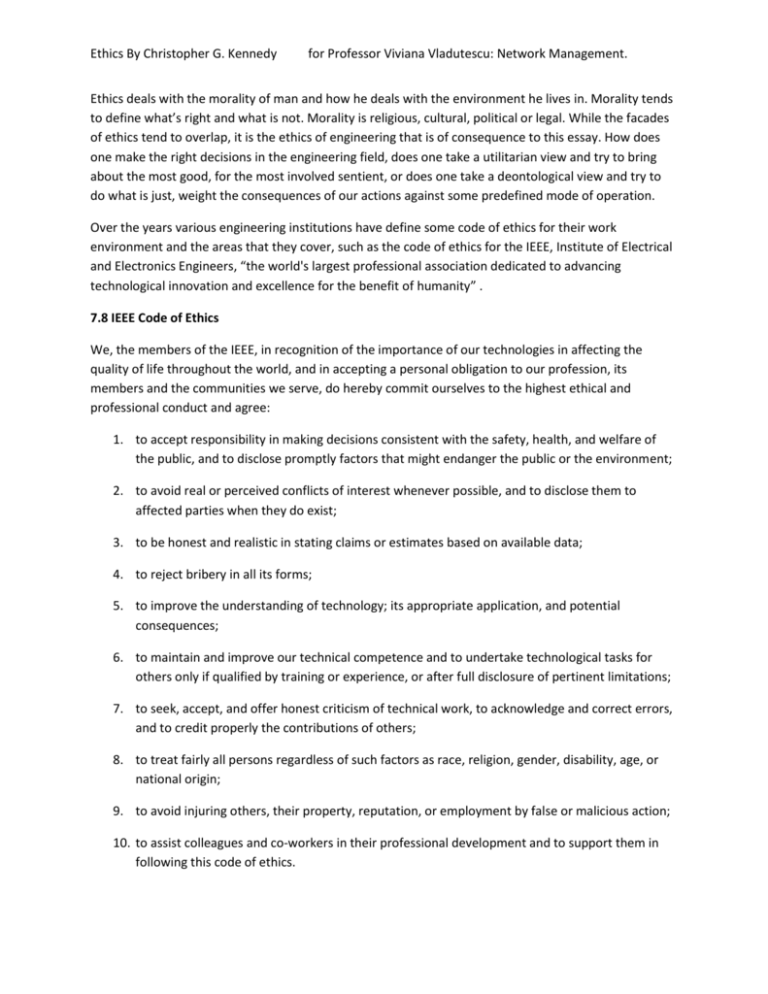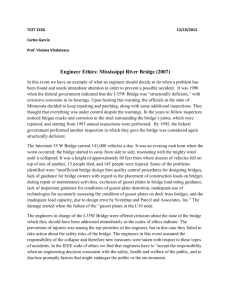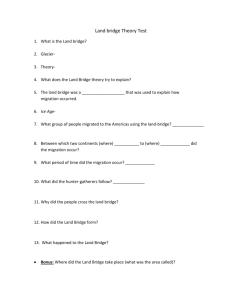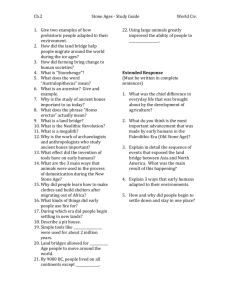Ethics deals with the morality of man and how
advertisement

Ethics By Christopher G. Kennedy for Professor Viviana Vladutescu: Network Management. Ethics deals with the morality of man and how he deals with the environment he lives in. Morality tends to define what’s right and what is not. Morality is religious, cultural, political or legal. While the facades of ethics tend to overlap, it is the ethics of engineering that is of consequence to this essay. How does one make the right decisions in the engineering field, does one take a utilitarian view and try to bring about the most good, for the most involved sentient, or does one take a deontological view and try to do what is just, weight the consequences of our actions against some predefined mode of operation. Over the years various engineering institutions have define some code of ethics for their work environment and the areas that they cover, such as the code of ethics for the IEEE, Institute of Electrical and Electronics Engineers, “the world's largest professional association dedicated to advancing technological innovation and excellence for the benefit of humanity” . 7.8 IEEE Code of Ethics We, the members of the IEEE, in recognition of the importance of our technologies in affecting the quality of life throughout the world, and in accepting a personal obligation to our profession, its members and the communities we serve, do hereby commit ourselves to the highest ethical and professional conduct and agree: 1. to accept responsibility in making decisions consistent with the safety, health, and welfare of the public, and to disclose promptly factors that might endanger the public or the environment; 2. to avoid real or perceived conflicts of interest whenever possible, and to disclose them to affected parties when they do exist; 3. to be honest and realistic in stating claims or estimates based on available data; 4. to reject bribery in all its forms; 5. to improve the understanding of technology; its appropriate application, and potential consequences; 6. to maintain and improve our technical competence and to undertake technological tasks for others only if qualified by training or experience, or after full disclosure of pertinent limitations; 7. to seek, accept, and offer honest criticism of technical work, to acknowledge and correct errors, and to credit properly the contributions of others; 8. to treat fairly all persons regardless of such factors as race, religion, gender, disability, age, or national origin; 9. to avoid injuring others, their property, reputation, or employment by false or malicious action; 10. to assist colleagues and co-workers in their professional development and to support them in following this code of ethics. Ethics By Christopher G. Kennedy for Professor Viviana Vladutescu: Network Management. This code of ethics has been refined to give a cover-all basis for conduct in the engineering field and as such could be used for any business model or organizations. Morality in is basic sense is to prevent harm to others, though at times it demands inflicting harm as a form of punishment, and even in such a case it demands that a punishment fits the crime, not an eye for an eye, but one that gives a just outcome and prevents future harm. One of the cases that were reviewed for this essay was the case of The I-35W Mississippi River Bridge, officially known as Bridge 9340 which collapsed August 1, 2007. The tragedy injured a 145 people and killed 13, during the evening rush hour. What happened on such a busy bridge that was inspected annually to ensure the safety of the bridge and its traversers? In 2005, the bridge was rated as "structurally deficient" and in possible need of replacement, according to the U.S. Department of Transportation's National Bridge Inventory database, also there was no inspection report completed in 2007, due to the ongoing construction work on the bridge. What happen? Well a day after the incident, the then Governor of Minnesota on August 2, 2007, Governor Tim Pawlenty stated that the bridge had been scheduled to be replaced in 2020. Picture showing the aftermath of collapsed I-35W Mississippi river Bridge. A bridge scheduled for replacement and the date set 13 years into the future. What caused the failure of the bridge, numerous reports citing concerns were made over the years; in 1990, the federal government gave the I-35W Bridge a rating of "structurally deficient," citing significant corrosion in its bearings. A 2001 study by the civil engineering department of the University of Minnesota, stated “that cracking had been previously discovered in the cross girders at the end of the approach spans. The main trusses connected to these cross girders and resistance to motion at the connection point bearings were leading to unanticipated out-of-plane distortion of the cross girders and subsequent stress cracking”. However, that situation was addressed by drilling the cracks to prevent further propagation and adding support struts to the cross girder to prevent further distortion. The report also noted a concern about lack of redundancy which is a secondary support system, in the main truss system, “which meant the bridge had a greater risk of collapse in the event of any single structural failure”. The report concluded with a statement “that the bridge should not have any problems with fatigue cracking in the foreseeable future. In 2005, the bridge was reported again as being "structurally deficient and in possible need of replacement.” An inspection carried out June 15, 2006 found problems of cracking and fatigue. To remedy this situation, a plan was made in December 2006; a steel reinforcement project was planned Ethics By Christopher G. Kennedy for Professor Viviana Vladutescu: Network Management. for the bridge. The project was canceled in January 2007 in favor of periodic safety inspections, after it was revealed that drilling for the retrofitting would in fact weaken the bridge. There were also talks internally in the Minnesota Department of Transportation by bridge officials who were concerned about the possibility of the bridge collapsing and worried that it might have to be condemned. The construction taking place in the weeks prior to the collapse included joint work and replacing lighting, concrete and guard rails. At the time of the collapse, there were 575,000 pounds (261,000 kg) of construction equipment and supplies on the bridge and four of the eight lanes were closed for resurfacing, this fact alone could have been the sole reason for the collapse of the bridge, being that forces on a bridge are normally proportionally distributed and the concentration of construction material alone in one section, relocated traffic strain, plus prior shoring up of the bridge with an inch 8layer of concrete, had put forces on the bridge that it was not designed for and of a surety had placed the bridge way pass safety tolerances. Photos from a June 2003 inspection of the bridge showed gusset plate bowing. June 2003 picture released by the National Transportation Safety Board, showing bowed gusset plates. The report that made the conclusion of the matter On November 13, 2008, the National Transportation and Safety Board released its findings from the investigation into the failure of the bridge; “the primary cause was the under-sized gusset plates, at 0.5 inches (13 mm) thick. Contributing to that design or construction error was the fact that 2 inches (51 mm) of concrete were added to the road surface over the years, increasing the dead load by 20%. Also contributing was the extraordinary weight of construction equipment and material resting on the bridge just above its weakest point at the time of the collapse. That load was estimated at 578,000 pounds (262,000 kg) consisting of sand, water, and vehicles”. Ethics By Christopher G. Kennedy for Professor Viviana Vladutescu: Network Management. National Transportation Safety Board photo showing fracture in a gusset plate that played a key role in the collapse of the Interstate 35W Bridge. The ethical issues in the situation are numerous, as there are factors such as the coal- gas manufacturing plant that was directly below the bridge and over the years have released toxin and corrosive gases, which aided in the deterioration of the bridge, also the black ice prevention system installed on the bridge which used potassium acetate, which can be corrosive to metals. The issues concerning the collapse seem to be cascading, and to draw the conclusion that bowing gusset plates caused the collapse in over simplifying the cause. From the first reports that the bridge was unsafe and that it needed replacing, the bridge should have been decommissioned, or used in a limited capacity until suitable alternatives or fixes could have been implemented. It seems no one organization wants to take the blame, instead a path of innocence or ignorance to an overstated matter of the safety of the bridge is being taken. Ethical behavior demand that harm be prevented and that suitable action are taken to prevent harms when they are made known. In the case of the collapses of I-35W Bridge, there were many oversights to critical matters, short term plans instead of looking long term. This is a classic case of a technological fix, instead of a solution. Feasibility research needed to be done to see the effects of the modifications and repairs that were ongoing, how they could have affected the structural integrity of the bridge. [An employee of the NTSB had written his doctoral thesis on possible failure scenarios of this specific bridge while he was a student at the nearby University of Minnesota. That thesis, including his computer model of the bridge for failure mode analysis, was used by the NTSB to aid in their investigation], this seem to put icing on the cake that the bridge was bound for failure, with such forethought, a tragedy such as this should have been prevented, if ethical actions were involved, and responsibility was taken by the involved parties, this matter would have never made the news. The ethical plus of the situation was that, for that year all bridges of similar design were thoroughly inspected and upgrades were made. As stated in the code of ethics at the start of this essay, if we seek to prevent harm to others, take responsibility for our action, seek to better our fellow man by sharing honestly, factual data, provide true criticism, learn from it, reject bribery, then we will never have a another collapsed bridge in America, as we would be proactive instead of reactive.








